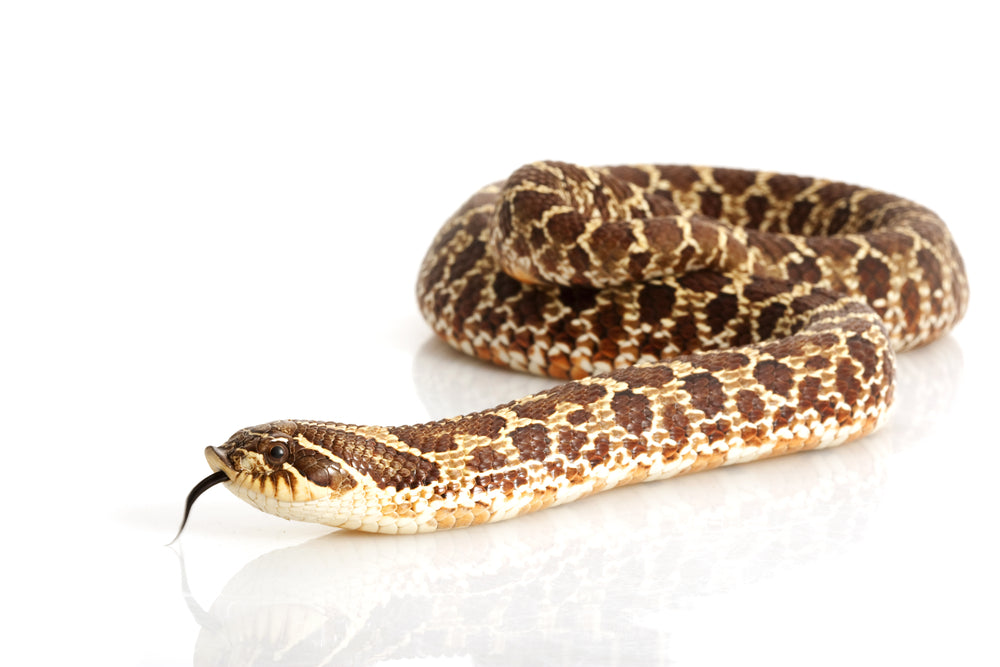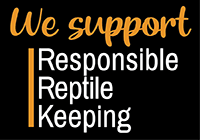Hognose Snake Caresheet

Hognose Snake Care Sheet
North American Hognose Snake (Heterodon spp.)
Skill Level: Easy – Intermediate
North American hognose snakes are a type of fossorial (burrowing) snake native to southern Canada, northern Mexico, and most of the United States. They are named for their hog-like upturned noses, which are actually an evolutionary adaptation that helps them dig tunnels and unearth prey.
Hognose snakes are diurnal, which means that they are most active during the day. In the wild, they spend most of their waking hours looking for food like toads and other amphibians — although they are known to eat reptile eggs and the occasional small mammal as well.
Depending on gender and exact species, hognose snakes can grow anywhere between 14-46” long, with females generally being much larger than males. Hognose snakes can be expected to live about 10-15 years with good care.
There are four species in the Heterodon genus:
- kennerlyi (Mexican Hognose)
- nasicus (Western Hognose)
- platirhinos (Eastern Hognose)
- simus (Southern Hognose)
The western hognose is the most common type of hognose snake in the US pet trade. For more detailed information on the species of the Heterodon genus, visit ReptiFiles.
Hognose snakes are venomous, but fortunately they are rear-fanged, and the venom is not significantly harmful to humans.
What you will need for a pet hognose snake:
- 40 gallon (36” x 18” x 18”) front-opening reptile enclosure, minimum
- Zoo Med Basking Spot Lamp, 100 Watt
- Exo Terra Reptile Glow Light Clamp Lamp, medium
- plug-in lamp dimmer
- Bio Dude Digital Thermometer / Hygrometer
- temperature gun
- Arcadia Forest D3 6% UVB T5 Bulb, 22”
- The Bio Dude Solar Grow T5 HO Single Bulb Light Strip, 24” (x2)
- Zilla 24/7 Digital Timer Power Center
- Large flat basking rock
- Terra Firma Bioactive Kit, 40 breeder
- decorations: branches, plants, cork logs, rocks, etc.
- large water bowl
- 12” soft-tipped feeding tweezers
Terrarium Size
The general rule for determining minimum enclosure size for a terrestrial snake is as follows:
- length = snake length
- width = half snake length
- height = half snake length
Considering the wide variety in adult lengths for hognose snakes, some small males may be able to be comfortable in a 20 gallon tank. However, bigger is always better, and if you don’t know exactly how long your snake is going to grow, 40 gallons is a safer general minimum.
Front-opening terrariums work well for housing snakes because they’re more difficult to escape from. They also make access easier, which decreases handling-associated stress for the snake and increases overall convenience.
Some advise housing young hognose snakes in small enclosures until they reach adulthood. However, as long as your hognose is not very young (i.e. near hatchling size), and they have plenty of places to hide, your juvenile hognose should be able to live in an adult-sized enclosure with no issues.
Hognose snakes are not social animals, so multiple snakes should not be kept in the same enclosure.
Lighting
Having a light on in your hognose snake’s enclosure helps them regulate their day/night rhythm and stimulates activity. This is especially important considering that hognose snakes are most active during the day.
If you’re building a bioactive hognose snake vivarium with live plants, then you will need a full-spectrum (roughly 6000K) plant light to “feed” your plants and keep them healthy. This daylight-mimicking bulb is also beneficial to snakes.
There is a widespread myth that snakes don’t “need” UVB, and therefore there’s “no reason” to provide it — some people even mistakenly cite potential issues such as stress and eye damage as reasons why not to provide UVB. However, there is mounting scientific evidence to the contrary: UVB is, in fact, beneficial to snakes, especially the diurnal ones. For this reason we recommend the Zoo Med T5 HO ReptiSun 5.0 or Arcadia Forest 6%, long enough to cover about 1/2 of the enclosure.
Lights should be left on for 12 hours/day. Nighttime lighting and colored bulbs are not necessary.
Heating
Hognose snakes, like other reptiles, are cold-blooded. This means that they rely on their environment to regulate their body temperature, which in turn regulates healthy metabolism and processes such as digestion. So they need to have a range of temperatures within their enclosure that enables them to regulate their temperature as needed.
Temperatures for western and Mexican hognoses:
- Basking zone: 90-95°F
- Cool zone temps: 70-80°F
- No cooler than 70°F at night
Temperatures for eastern and southern hognoses:
- Basking zone: 86-88°F
- Cool zone temps: 70-75°F
- No cooler than 70°F at night
People may try to tell you that you should use a heat pad for your heating your snake, but this is in fact an outdated practice and does not allow a hognose to thermoregulate properly — especially not if you’re using a thick bioactive substrate.
Instead, use a halogen flood heat bulb to mimic the effects of the sun in a hognose snake’s natural environment. Place the bulb in a dome heat lamp for best results. If you have a larger snake that needs a basking area larger than one lamp can provide, try using two smaller dome lamps placed next to each other. It’s also good practice to plug the lamp(s) into a lamp dimmer so you can dial the bulb down if it gets too hot.
Your heat lamp should be placed on the extra left or right of the enclosure, as this will help create a healthy temperature gradient. Measure this gradient with a temperature gun for quick at-a-glance data, but you should also have a digital probe thermometer placed on the basking spot so you can keep an eye on the basking temperature.
Humidity
Western and Mexican hognose snakes thrive between 30-50% humidity.
Eastern and southern hognose snakes thrive between 50-60% humidity.
Correct humidity levels help maintain respiratory health and facilitate proper shedding, which is a regular part of your snake’s life. Maintain good humidity by regularly watering your plants, using a deep substrate layer, and misting with a spray bottle as needed. It’s a good idea to mist a little extra when your snake is about to shed.
You can keep track of the humidity levels in your snake’s enclosure with a digital probe hygrometer. The probe for this device should be placed on the substrate on the cool end of the vivarium.
Substrate
Considering that hognose snakes are fossorial, it’s extra important to provide a thick layer of a substrate that they can easily dig in. Aside from encouraging natural behaviors, the right substrate will enable the snake to thermoregulate more naturally and promote healthy humidity levels.
For these reasons, a bioactive substrate is a great way to meet your hognose’s needs. Bioactive substrates mimic the function of soil in a reptile’s natural habitat, so things like coconut fiber or aspen shavings aren’t going to work. Instead, you can make your own bioactive mix with 2 parts organic topsoil, 2 parts Zoo Med Reptisoil (or similar), and 1 part play sand, or you can let The Bio Dude do the work for you with a 40 breeder Terra Firma Bioactive Kit.
Because you’re setting up a bioactive habitat, you will need to mix and layer the substrate with sphagnum moss and leaf litter. For best results, combine with an appropriate amount of Bio Dude Bio Shot reptile-safe fertilizer.
Decorating the Enclosure
Just because hognose snakes are fossorial doesn’t mean they can’t benefit from some above-ground décor! Aside from beautifying your snake’s habitat, décor also adds variety to your miniature landscape and maximizes the available space in your enclosure by giving the snake lots of things to explore and utilize. So feel free to clutter it up!
Here are some ideas of ways that you can decorate and enrich your hognose snake’s bioactive vivarium:
- cork flats
- hollow logs
- branches
- hides/caves
- plants
- décor
Feeding Your Hognose Snake
Like other snakes, hognose snakes are carnivores. This means that they need to eat whole animals in order to get the nutrients that their bodies need.
Generally speaking, young and growing hognose snakes should receive one pinky mouth every 3-4 days, and adult hognose snakes should get 2-3 rat fuzzies once every 7-14 days. It is best to use prey items that are hairless or nearly hairless, as it is speculated that hair may cause digestive problems for hognose snakes.
Prey items should be about the same diameter as the snake’s head. As the snake grows, you can gradually increase the size of the prey. Picky eaters may need to have their prey scented with frog scent or tuna water.
Watering Your Hognose Snake
Keep a large bowl (big enough for the snake to coil up in) of water in the enclosure at all times. Change the water at least twice weekly — daily is best. When the bowl gets soiled, scrub it out with an animal-safe disinfectant like chlorhexidine or F-10SC before replacing.
Handling Tips
After bringing your new pet home, do not handle it until it is eating regularly. This can take anywhere from two weeks to two months, so be patient and use this time to make sure your husbandry is on point. Once your snake is ready for handling, handle it at least 1-2x weekly to keep it accustomed to you, but no more than once daily.
Wash Your Hands First
Before you pick up your hognose snake, first wash your hands with soap or hand sanitizer. This removes potentially harmful bacteria, viruses, or parasites from your hands, as well as makes your hands smell distinctly inedible. Hognose snakes find prey via heat and smell. If your (warm) hands smell like mouse, frog, animal, or anything else remotely appetizing, your pet may confuse you for food.
How to Pick Up a Snake
Next, use a paper towel roll to tap its head (gently). This sets expectations by letting the snake know that it’s time for handling, not food. Pick it up with two hands, one behind the head and one supporting the rest of the body. NEVER pick up a snake by its tail — this can really hurt their spine!
Safety with Snakes
Always supervise children closely when they are handling a pet snake (or any kind of pet, frankly). This is as much for the snake’s safety as it is for the child’s.
DO NOT Handle If…
Don’t handle your snake within 24-48 hours of a meal, as this can stress them out and lead to regurgitation, which is a traumatic experience that can actually lead to death.
Also do not handle if your pet’s eyes have turned opaque or cloudy. This means that the snake is preparing to shed and can’t see well, making them more jumpy than usual and more likely to bite out of self-defense.
Care information courtesy of ReptiFiles. Visit ReptiFiles.com for further information on hognose snake care.
- Tags: hognose snake
- Josh Halter










